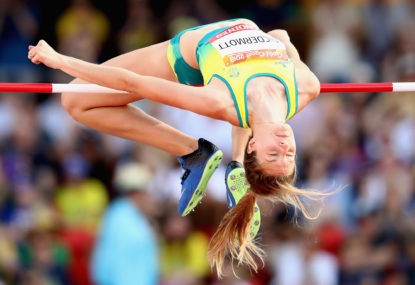Highjumping is not just a sport; it’s an exhilarating dance between gravity and ambition. Picture athletes soaring through the air, defying physics with each leap. Whether you’re a seasoned competitor or someone who has simply admired this breathtaking feat from afar, there’s something undeniably captivating about highjump It’s an art form that combines strength, technique, and mental fortitude.
In this ultimate guide to highjumping, we’ll explore everything there is to know about this thrilling discipline. From its origins in ancient times to modern-day techniques used by elite jumpers, get ready to dive deep into the world of highjumping. You’ll discover strategies for improving your own jumps, learn about common pitfalls to avoid, and find inspiration from legendary jumpers who have pushed the boundaries of what’s possible.
So lace up your shoes and prepare for takeoff as we journey through the heights of highjump!
What is Highjumping?
Highjumping is an athletic event that showcases the incredible ability to leap over a horizontal bar set at varying heights. Athletes sprint toward the bar, then launch themselves into the air using a combination of speed and technique.
The goal is simple: clear the bar without knocking it down. What makes highjumping fascinating is how different styles can impact performance. Each jumper has their unique approach, from the way they take off to their body positioning in mid-air.
This sport requires not just physical strength but also mental agility. Jumpers must calculate their timing, angle of takeoff, and trajectory—all while feeling adrenaline coursing through their veins.
Whether performed on a track or during field events at major competitions, highjumping captivates audiences with its blend of grace and raw power. It’s this thrilling mix that draws both athletes and fans alike to witness each spectacular jump.
The History of Highjumping
Highjumping has a rich and varied history that dates back to ancient times. Evidence suggests that the sport was practiced by the Greeks, who incorporated it into their Olympic Games as early as 776 BC.
In those early days, athletes used primitive techniques to clear obstacles. The event evolved significantly with the introduction of new styles and training methods over centuries.
During the late 19th century, highjumping gained popularity in schools and universities worldwide. The innovation of different jumping techniques like the straddle jump emerged during this period.
The Fosbury Flop revolutionized highjumping in the late 1960s, thanks to American athlete Dick Fosbury. His unconventional backward approach transformed how athletes viewed height clearance.
Today, highjumping is celebrated for its blend of skill and athleticism while being an integral part of major sporting events like the Olympics and World Championships.
Types of Highjumping
Highjumping has evolved into several distinct styles, each showcasing unique techniques and approaches. The most popular is the **Fosbury Flop**, where athletes clear the bar backwards, arching their backs over it. This method emphasizes speed and technique.
Then there’s the **Straddle Technique**. Here, jumpers face forward as they go over the bar. It allows for a more controlled takeoff but requires significant flexibility.
The **Scissors Jump** offers another option, particularly for beginners or those looking to learn highjump basics. In this style, athletes leap with one leg leading while scissoring their legs apart in mid-air.
Some competitors use variations of these traditional styles tailored to their strengths or preferences. Each type presents its own set of challenges and advantages that can greatly influence performance on the field.
Techniques and Strategies to Improve Your Highjump
Improving your high jump requires a mix of technique and strategy. Start with the approach run. Consistency is key; practice finding that sweet spot where you feel most comfortable.
Next, focus on your take-off. A powerful leap combined with proper foot placement can make all the difference. Your plant foot should strike firmly to provide maximum lift.
Body position during flight matters as well. Aim for a streamlined posture, keeping your hips elevated to clear the bar efficiently.
Incorporate plyometric exercises into your training routine to build explosive strength in your legs and core.
Visualize success before each jump. Mental preparation enhances physical performance by boosting confidence and reducing anxiety right before you launch into the air.
Physical and Mental Preparation for Highjumping
Physical preparation for highjumping involves a comprehensive training regimen. Strengthening your legs and core is crucial. Exercises like squats, lunges, and plyometrics build explosive power. Flexibility also plays a significant role; incorporate dynamic stretching into your routine to enhance your range of motion.
Mental preparation shouldn’t be overlooked. Visualization techniques can help you envision success before the jump. Picture yourself clearing the bar effortlessly—this mental rehearsal boosts confidence.
Focus on goal setting as well. Establish short-term milestones along with long-term aspirations to keep motivation high. Journaling your progress can provide insights into what works or needs adjustment.
Practice mindfulness or breathing exercises to manage pre-competition nerves effectively. Staying calm under pressure contributes significantly to performance on the day of competition, ensuring that both body and mind are aligned for optimal results in highjumping.
Common Mistakes to Avoid in Highjumping
Many aspiring high jumpers fall into common traps that can hinder their progress. One significant mistake is neglecting the approach run. A consistent and well-calibrated approach is crucial for generating the necessary speed and rhythm.
Another frequent error involves poor takeoff technique. Jumpers often underestimate the importance of jumping off one foot while maintaining body control. Failing to execute this properly can result in a lower jump height.
Additionally, many athletes focus solely on physical strength without honing flexibility and technique. Stretching helps improve range of motion, allowing for better execution during jumps.
Inexperience with equipment can lead to mishaps as well; not adjusting pole heights correctly or using unsuitable footwear may compromise performance.
Mental distractions play a big role too. High jumpers who overthink their jumps are more likely to underperform. Staying focused on form rather than outcomes can make all the difference.
Famous High Jumpers and Their Achievements
High jumping has seen some remarkable athletes who have etched their names in history. One of the most legendary figures is Javier Sotomayor from Cuba. He set the world record at an astonishing 2.45 meters in 1993, a feat that remains unbeaten.
Another iconic jumper is Dick Fosbury, known for revolutionizing the sport with his “Fosbury Flop.” This technique helped him secure a gold medal at the 1968 Mexico City Olympics and changed how high jumpers approach the bar.
Then there’s Stefan Holm from Sweden, celebrated for his consistency and skill. Holm captured Olympic silver in Athens and numerous European titles throughout his career.
Each of these athletes brought something unique to high jumping, inspiring countless others to reach new heights both literally and figuratively. Their contributions continue to influence aspiring jumpers today.
Safety Precautions for Highjumping
Safety is paramount when it comes to highjumping. Proper equipment can make a significant difference. Always use a well-maintained high jump mat designed to absorb impact effectively.
Warm-up routines are essential before attempting jumps. Stretching the muscles helps prevent injuries, particularly in the hamstrings and calves.
Ensure that your jumping area is clear of obstacles. This minimizes risks associated with falls or missteps during practice.
Always perform under supervision if you’re new to the sport or trying advanced techniques. A coach can provide valuable feedback and ensure you’re using correct form.
Be mindful of your body’s signals. If something feels off, take a break and reassess your technique or condition to avoid long-term injury.
Conclusion
Highjumping is more than just a sport; it’s an art that combines skill, strength, and strategy. By understanding its history and various techniques, athletes can elevate their performance. With the right preparation—both physically and mentally—highjumpers can reach impressive heights.
Avoiding common mistakes helps ensure a smooth journey in this exhilarating discipline. Learning from the legends of highjumping inspires new generations to push boundaries and aim higher.
Safety measures are crucial for successful training sessions and competitions alike. As you immerse yourself in the world of highjumping, remember highjump that each leap is an opportunity for growth and achievement. Embrace the challenge with passion, dedication, and focus; your next jump could be your best yet!

